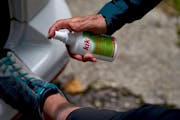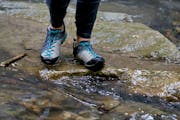Ruedi Thomi
Tick bites are unpleasant and, in the worst-case scenario, can spread disease. This is why it’s important to protect yourself against ticks. Here are a few tips for effective tick protection.
Ticks are often teeny-tiny, just a few millimetres in size. However, tick bites can have major consequences. These little parasites can carry diseases such as tick-borne encephalitis (TBE) – which is why protecting yourself against ticks is so important.
You should exercise particular caution when on adventures in the forest or in high grass, where you’ll come across the most ticks. They prefer lower elevations; you’ll hardly find them above 1,500 metres.
Tips for protecting yourself from tick bites

Cover your skin as much as possible
Ideally, don’t give the ticks any chance to bite you. The best way to do this is by avoiding exposed skin – so wear long trousers and long-sleeved tops.

Tuck your trousers into your socks
When you’re in areas that could be home to ticks, you should tuck your trousers into your socks to protect vulnerable body parts like your ankles. This is particularly important when walking through tall grass or thick undergrowth.

Use insect repellent
Before you go on your outdoor adventure, apply tick spray. This comes in various strengths, is dermatologically tested and is also suitable for children. It’ll generally keep ticks at bay for up to five hours.

Wear closed-toe shoes
In addition to long clothing, you should wear closed-toe shoes to protect yourself against ticks. Avoid wearing sandals or flip-flops in tick-infested areas and opt for closed-toe shoes with a tall shaft.

Examine your body
When you get home, examine your body for ticks: your armpits, the backs of your knees and your genitals are particularly vulnerable. You should also check your ankles carefully.
Discovering a tick bite
Even if you take tick protection seriously, a tick might still bite you. It’s important to note that these parasites are very tiny when they’ve just bitten you. So, look for these little brown insects on your body after you’ve finished your stint outdoors. Often, they’ll scrabble around to start with before they find the perfect spot on your skin. Once a tick has bitten you, the area will be slightly red and itchy, with the tick like a black spot at its centre.
What to do if you’ve got a tick bite
If a tick is embedded in your skin, you should remove it as quickly as possible. To do so, take a pair of tweezers or a tick removal card. Try to grab the tick as close to the skin as possible so you remove the head, too. Pull it out slowly in a vertical direction; don’t twist it. There’s no need for household remedies like oil or toothpaste: they don’t work. Disinfect the bite after you’ve removed the tick.
If the bite turns red over the next few days, you suffer flu-like symptoms or feel nauseous, it’s crucial that you contact your doctor.
High-risk areas for ticks in Switzerland
The Federal Office of Public Health (FOPH) publishes a risk map flagging areas where tick bites are associated with an enhanced risk of disease (such as tick-borne encephalitis, TBE).
Clothing with insect protection
Share the articleClothing and repellent: how to protect yourself against ticks
- Free shipping from CHF 99
(With the TransaCard always free of charge)
- Secure payment with Twint, Visa and more
- 14 days cancellation right
































